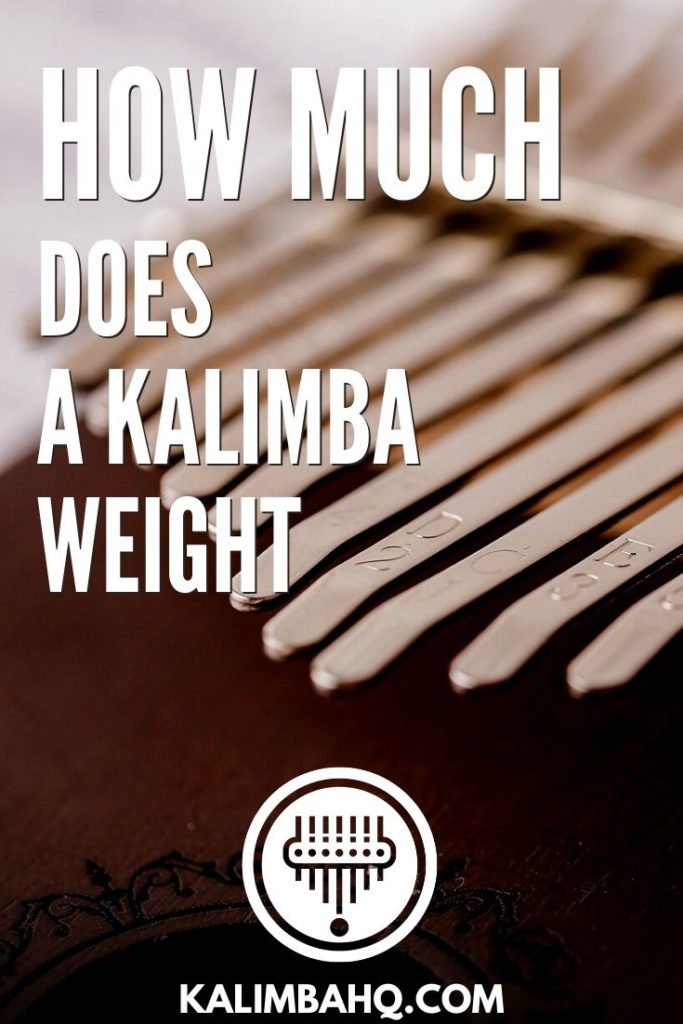Kalimba or mbira is a musical instrument that originated in Africa. It has a wooden board that is often a resonating box, with metal tines or “teeth” attached to it. The instrument is played by plucking the tines with thumbs while holding it in your hands.
So, how much does a kalimba weigh? There are several different types of kalimba, and depending on it, it can weigh between two ounces (around 60 grams) and 2.2 pounds (1 kilogram).
Kalimbas come in all shapes and sizes and based on the model, the weight can vary. You can also get models with a protective case which will only make it heavier.
What Affects The Kalimba Weight
One of the main things that will affect the weight of the instrument is the type. Since there are so many variants and different materials used to create it, the weight of the instrument can vary.
Naturally, the difference won’t be as significant as with larger instruments since kalimba is rather small compared to bass or guitar.
Number Of Keys

The first thing I will mention that can have an impact on the overall weight of this “thumb piano” is the number of keys. Kalimba, as an instrument, is not standardized, which means that you can find different types with different numbers of keys.
Furthermore, each will be set up to a different tuning as well. As a result, the more keys the instrument has, the heavier it will be. Even though the tines are made of aluminum, they still have their own weight that will impact the overall weight of the kalimba.
Similarly, to achieve a specific tone, each tine is a different length. The longer ones will naturally be heavier since they are made of the same material, but with different dimensions. Depending on the musician’s skills, they will get kalimba with more or fewer keys. For beginners, the instrument will usually have less than ten keys, while more serious instruments will have more.
The most common type of kalimba has seventeen tines, and the number of keys is often an odd number. So, you can find ones with five, seven, nine, fifteen, seventeen, and so on. However, it is still possible to find instruments with even number of keys like eight, ten, twelve, etc.
Type Of Kalimba

The second factor for the weight of kalimba is the type of instrument. Firstly, there are kalimbas that consist only of a wooden board with tines attached to it. On the other hand, you can find ones with resonators which are a bit larger.
Besides the different number of keys, you can get treble and alto kalimba as well. These, of course, come in different sizes as well. If we take a look at the Alto kalimba, the size of the box is 8 x 5.5 x 1.5 inches, which is 20.3 x 14 x 3.8 centimeters. The treble kalimba, on the other hand, is a bit smaller with 7 x 5 x 1.25 inches or 17.7 x 12.7 x 3.18 centimeters.
While there is a slight difference in size between treble and alto, the former one has seventeen tines, unlike alto that has only fifteen. But that’s not the only difference between the two. The size of tines between these two models is also different. The alto kalimba has tines that are 5 millimeters wide (or 0.197 inches), while treble’s ones are 4 millimeters (or 0.157 inches).
Commonly, alto kalimba’s weight is around one pound which is 0.450 kilograms (or 16 ounces). Treble kalimba is a bit lighter, and it weighs 12 ounces or 0.335 kilograms. I should also mention that since most kalimbas are hand-made, the size can vary between each model. Sometimes, the wood can be thicker or thinner, which can result in different weights as well.
Finally, the shape of the instrument is something that artists can change as they seem fit. You can find simple kalimbas without a resonating box, where the shape of the board can vary from regular square to ones shaped like a cat’s head.
Type Of Wood

But even if we take two seemingly identical instruments, with the same shape, size, and a number of tines, the weight can be different in the end. The wood itself plays a major role in the overall weight of kalimba. Since the craftsmen can use almost any type of wood, based on its density, the weight can be lower or higher than you’d expect.
You can also find kalimbas that have a piece of wood where one part is blonde, while the other is dark brown. For example, light-colored kiaat wood is a lot less dense compared to the dark-colored one. As a result, alto kalimbas can be a couple of ounces lighter if you find ones made of kiaat. Dark wood can add between two and three ounces to standard alto kalimba.
Today, you can find kalimbas made from almost all types of woods. Among the most common ones are rosewood, sandalwood, curly maple, bamboo, koa, walnut, camphor, birch, spruce, and mahogany.
If you are looking for harder wood, rosewood is the most durable and can sustain 1780 lbf according to the Janka hardness test. On the other hand, spruce is the softest one with only 700 lbf.
But what is more important for the weight is density. The density of rosewood is between 50 and 55 lb per ft3 depending on the type. Maple is between 39-47, and mahogany can be anything between 31 and 53 lb per ft3 based on the type the manufacturer used. Naturally, the denser type of wood will be heavier, so finding a rosewood kalimba will prove to be heavier than the maple one. Of course, if their dimensions are the same.
Type Of Metal

Early models of kalimba had tines made of bamboo, but that was replaced with metal ones. These tines, tongues, or lamellas (as they are called), can be made using a variety of metals. Interestingly, people rarely mention the material used to create tines, even though it determines the sound of the instrument.
Tines on kalimbas are usually made from steel (stainless steel and spring steel), recycled metal, aluminum, and others. Bear in mind that each steel is different since it is an alloy of iron and carbon. The percentage of carbon in steel can vary, which means that different manufacturers will probably use different types of steel.
Similarly to wood, each type of metal will have a different density, and with it, different weights. While the tines itself are not that heavy, it might have a slight impact on the overall weight of kalimba.
The most common types of tines you can find today are stainless steel, spring steel, steel ore plated, and steel ore unplated.
Additional Variants
It is also possible to find kalimbas with a pickup. They will work the same way as the ones in acoustic guitars, which means that there will be a pickup in the soundbox, and a jack for the output. While the pickup itself is not really heavy, it can add a bit of weight to the kalimba.
Examples Of Kalimba Weight
Now, let’s take a look at some of the examples and weight of kalimbas you can find.
GECKO Kalimba with 17 keys
If you are looking for a great instrument, this might be the right choice. This thumb piano is made of mahogany, and it has seventeen keys. To make tines, GECKO used ore steel bars, which are comfortable for your fingers. Kalimba itself has a resonating box, and you can get a protective case if you plan on traveling with it. The weight of the whole package is 1.9 pounds.
AKLOT 17 keys solid wood kalimba
Even though it has the same number of keys, this model is a bit lighter with only 1.3 pounds. What is interesting is that you will get unique shapes and incredible quality. This handmade instrument is pretuned, which means that you can start practicing as soon as you get it.
Hugh Tracey Alto Kalimba
This alto kalimba has fifteen tines, and it is one of the most popular models you can find. The package itself is 2.2 pounds, and it’s made in South Africa

Donner 10 key kalimba
If you are a beginner, or if you are looking for something a bit simpler, Donner offers an incredible ten-key kalimba. The resonator is made of mahogany, and it comes in various tunings as well. For tines, Donner used carbon steel. This kalimba weighs 12.8 ounces.
GECKO 8 key kalimba
For anyone looking to try out this instrument, this pocket-size might be a perfect choice. Unlike previous models, there is no resonator, and tines are attached to the wooden board. The whole package weighs only 10.4 ounces.
Does Kalimba’s Weight Affect Tone?
As we could’ve seen, kalimba comes in all shapes and sizes. If you were wondering if the weight has any impact on the tone, the answer is no.
The weight itself won’t affect the tone in any way. But the components that change the weight will determine the tone. Based on the wood manufacturer used to create an instrument, the sound will change as well. The same applies to the tines.
However, the density will have an impact on the weight, but the materials will dictate the sound that comes out of kalimba.
How Much Does A Kalimba Weigh With A Case And A-Tuning Hammer?
If you already haven’t bought kalimba, the best option would be to get the whole package. Many manufacturers sell kalimbas with a protective case, as well as a tuning hammer that can help you keep your instrument in tune.
So, if you were wondering what the weight of this kind of package is, the answer is approximately 2 pounds. All of the factors we mentioned will have an impact on the weight of the package, and based on the kalimba you buy, it can vary.
Conclusion
Based on the type of kalimba you buy, the weight can be between a couple of ounces and over two pounds. The smallest models of kalimba with eight keys are around a bit over 2 ounces, which is approximately sixty grams. On the other hand, larger alto kalimbas like Hugh Tracey models are 2.2 pounds which is around one kilogram.
Standard kalimbas in the key of C often come with a tuning hammer, case, and instructions, which can slightly increase the weight, and they are around 2 pounds.
If you found this article useful you may want to save this pin below to your Kalimba board

Recent Posts
How To Play “How Deep Is Your Love” On Kalimba - Tabs Included
There are so many incredible songs you can learn to play on Kalimba, but if you are a beginner, the best idea would be to go easy. But finding a perfect song to learn is never easy. Fortunately, this...
Jingle Bells is among the most commonly sung (and the most well-known) songs in the world. Everyone heard of this one, and it is one of the go-to songs for beginner musicians. Regardless of...





